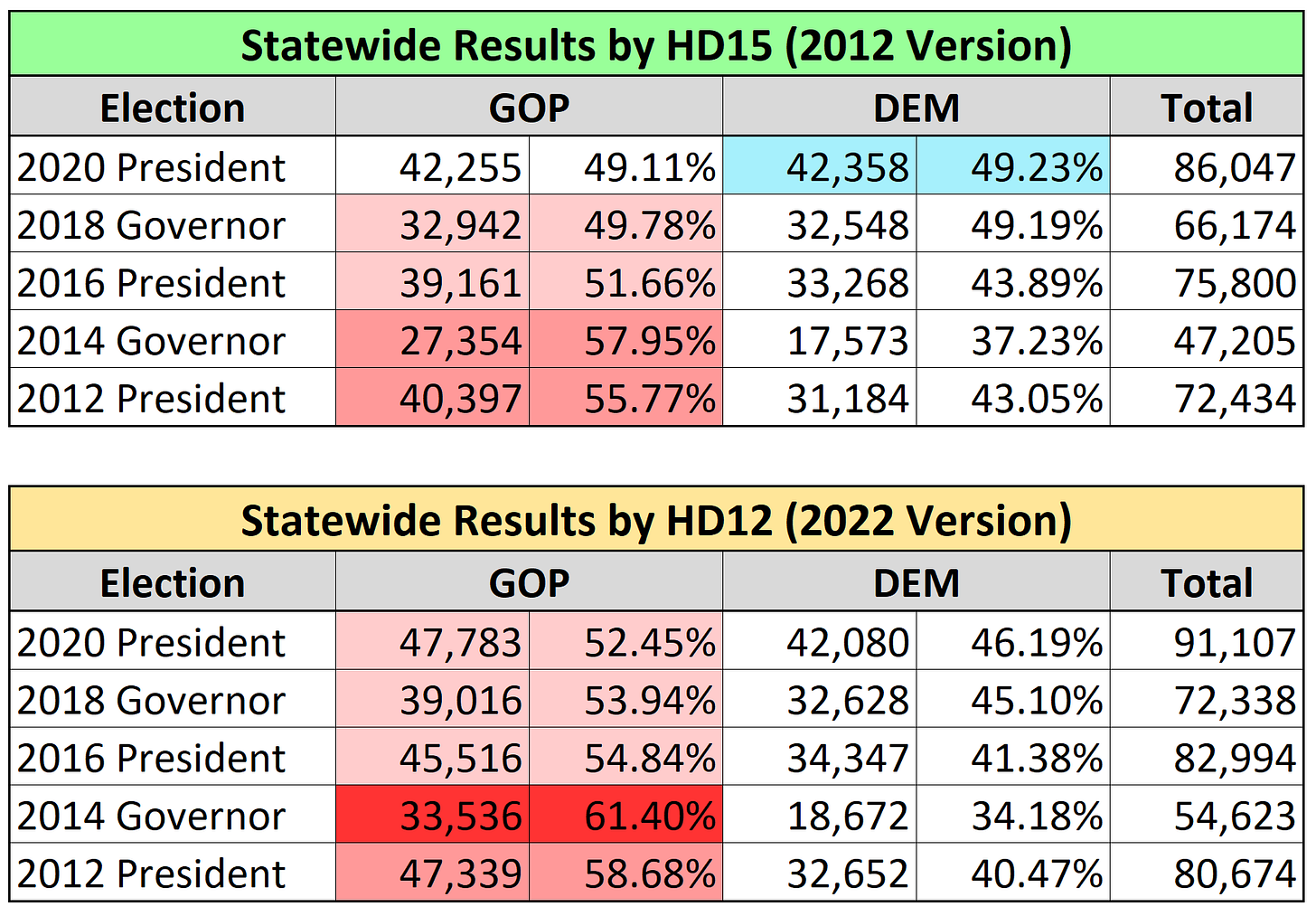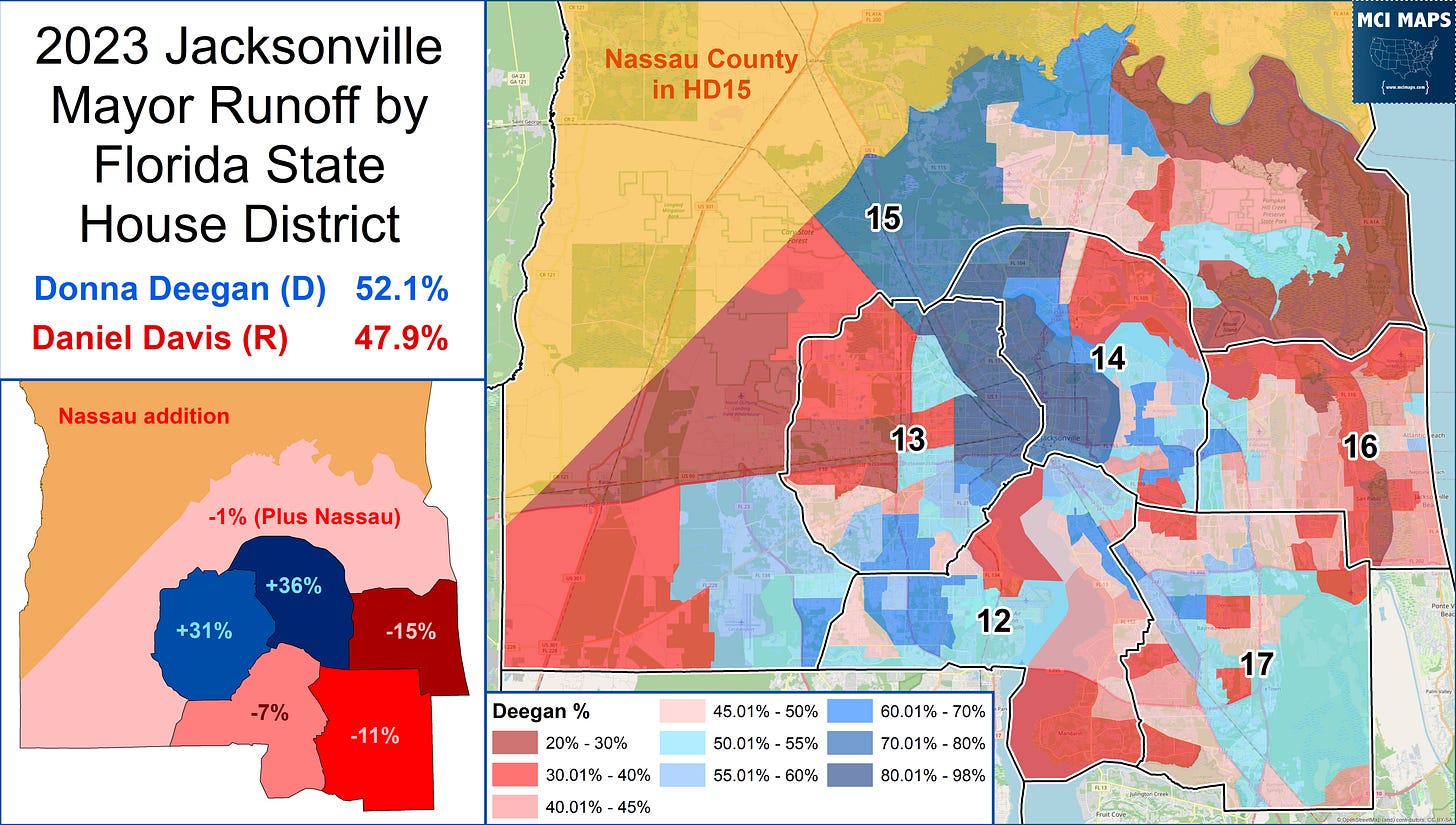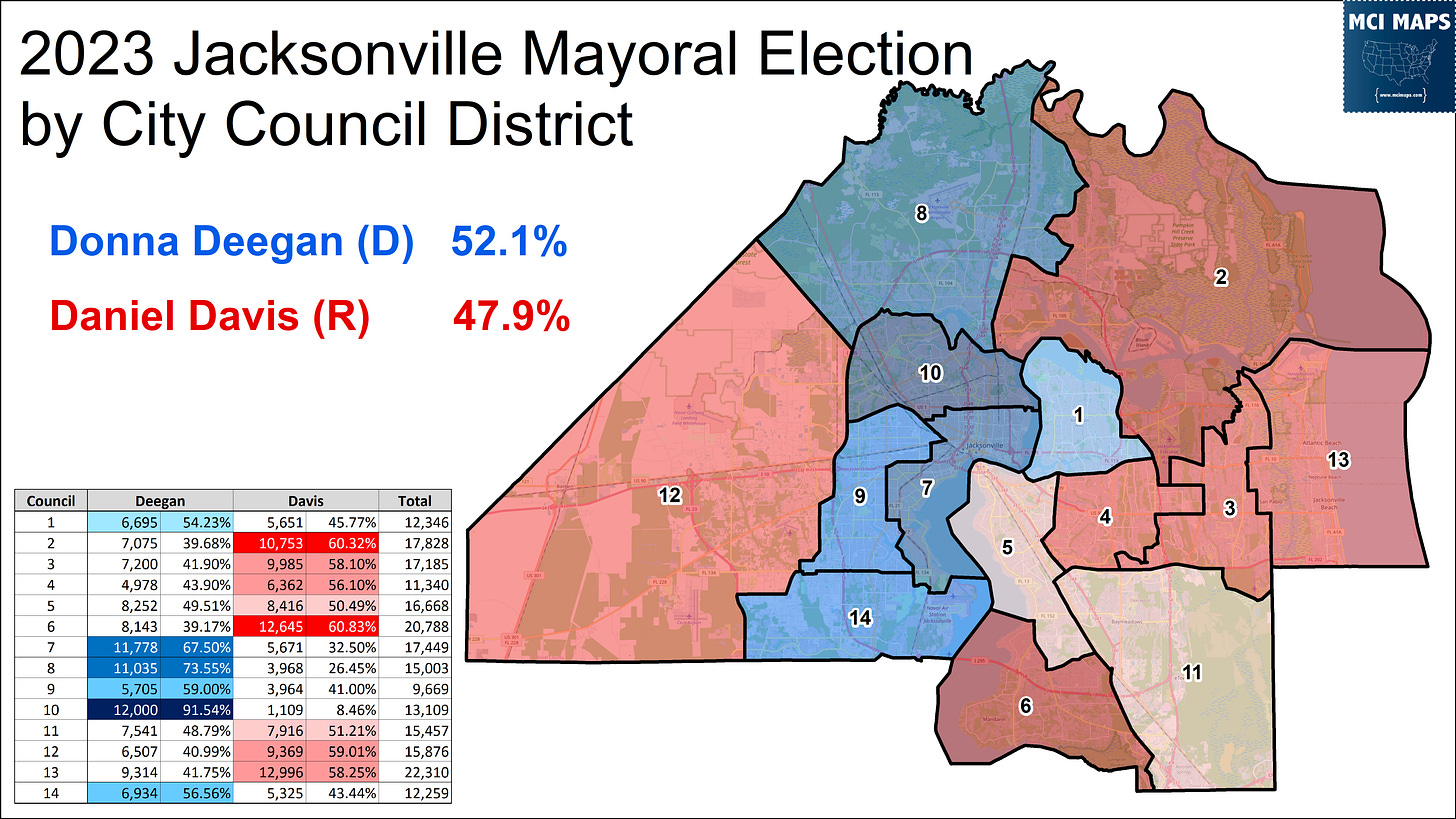A few weeks ago, Democrats in Florida got a major boost in moral when Donna Deegan flipped the Jacksonville Mayoral Office for Democrats. I covered that contest in detail here.
The results were not only a boost for Democrats, but they also confirmed a gerrymander in the region. No I am not referencing the city council districts, which were subject to a protracted legal battle. I am referring to the area’s state house districts.
The Old Districts
From 2012 to 2020, the Jacksonville area, made up of Duval and Nassau counties, were covered by six state house seats. The two counties made up a perfect sandbox that six seats could be drawn within and could all be in the proper population deviation range. While Florida’s Congressional districts must be within 1 person, the legislative seats allow for a small deviation, typical in many states. The older districts can be seen below.
In this map, district 11 was Nassau and Jacksonville’s beach towns, while all other seats were entirely in Duval county. Districts 13 and 14 were both black-majority districts and solidly Democrats. All remaining seats were solidly Republican.
However, this political dynamic did not last. District 15, which covered the diversifying suburbs of Jacksonville, began to grow more democratic due to a combination of non-white growth and GOP struggles with suburbs in the Trump era. In 2012, Mitt Romney won the district by 13 points. In 2020, Joe Biden narrowly took the seat.
That demographic shift is no joke there either. In 2010, the district was 60% white and 27% black. In 2020 it was 49% white and 33% black.
The district was suddenly in play, which started with an expansive contest that the GOP narrowly won in 2018. The area seemed destined to continue to grow in Democratic support, meaning HD15 only had a matter of time before it flipped blue.
So predictably, Republican map-makers put a stop to that.
The New Districts
As longtime readers of this substack know, the 2022 redistricting process in Florida was dominated by Ron DeSantis’ aggressive racial and political gerrymander of the Congressional map. While the Congressional plan is by far the most egregious, it wasn’t the only source of gerrymandering. The final state house plan for Jacksonville can be seen here.
It turned out that after population changes, the Duval-Nassau combo could continue to hold exactly six districts; which lawmakers preserved. The plan looks nice and compact. However, under it is a clear effort to gerrymander the region and preserve a 4 GOP and 2 DEM plan.
Here is how the two maps voted for 2020 President.
The new plan had two deep-blue seats and HD12, the closest successor to HD15, is now Trump +6. The main way this was achieved was by the district crossing the St Johns River - something not done in the older lines.
The river is a massive geographic landmark for the state. Republican lawmakers on countless times expressed a desire that districts not cross the River. This has been especially pronounced with State Senate plans - used as a way to never link Clay and St Johns Counties into one seat (something that would pair many prominent GOP politicians). River crossing has come up for local redistricting as well.
Think what you will about river crossing - but as I see it - GOP talking points on it are inconsistent.
Both sides of the River are very different from the other and the area is only connected by a major highway bridge. By drawing the lines this way, lawmakers could pack in a net GOP populace east of the river while shedding some of the democrats in the growing western suburbs.
Here is how both sets of lines overlay with the precinct results from 2020.
The new HD12 is very similar to the old HD15 in that both districts were solidly Republican a decade ago and have become more Democratic. The 2012-2020 political history for both the old and new seat can be seen below.
As the graphs above show, the new HD12 has become more democratic with time. Indeed most of the Jacksonville region outside of the already-deep-blue downtown have seen notable Democratic support growth.
Below is a map showing the swing in raw vote margins from 2016 to 2020. As you can see, the Jacksonville area is deep blue, one of the major sources of democratic gain in the state.
The map-makers could not negate the growth in Democratic strength, but they could slow it from overtaking another district.
The 2023 Mayoral race confirms the effectiveness of the gerrymander. In Deegan’s 4% countywide win, she still lost HD12 by 7%.
The race confirms that the map is a 4-2 plan, with only 13 and 14 going for Deegan. While the new HD15 was only narrowly Davis, that is without deep-red Nassau voting here - so make no mistake that is a red seat. In terms of Duval-only districts, Deegan only took 2 of the 5.
You may ask, how would the old 15th have voted? Well precinct splits are aggressive here, but my estimation is a 50.2% Deegan, 49.8% Davis district.
These current state house lines are a clear gerrymander.
Alternative Lines
Back in the early fall of 2021, before any legislative maps had been released, I looked at how redistricting in the Jacksonville area might go. I did predict the possibility of the GOP gerrymandering to short-circuit what was happening in HD15.
I drafted my own plan, which aimed to preserve the black-performing 13 and 14, but also turn 15 into a black-opportunity seat; one reflecting the diverse suburban growth in SW Jacksonville.
For this substack I made some slight clean-up of my initial idea, which is below.
This plan largely aims to retain the geography of the old lines, aiming for a continuity. The biggest changes came in SW Jacksonville. There, I linked HD15 to the St Johns River and used State Road 228 (Normandy Blvd) as its northern border. This creates a nice compact district that covers much of the growth in the area. My seat would be moderately democratic and majority black in a democratic primary. To me, this reflects the diverse growth happening in the region.
You may ask, how would these districts have voted in the Mayoral race? Deegan takes 3 seats now, not just 2.
The alternative 15 would be solidly in the Deegan camp. This makes sense considering Council districts 7, 9, and 14 easily go for Deegan as well.
In the council map, the era of packing black voters was severely reduced, allowing for more diverse districts and a map more balanced overall. I believe a better state house plan should follow.
Jacksonville deserves better.
















